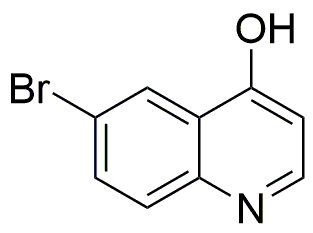6-Bromo-4-hydroxyquinoline is widely utilized in research focused on:
- Pharmaceutical Development: This compound serves as a key intermediate in the synthesis of various pharmaceuticals, particularly those targeting bacterial infections and cancer therapies.
- Antimicrobial Agents: It is effective in developing new antimicrobial agents, offering potential advantages over traditional antibiotics by targeting resistant strains.
- Fluorescent Probes: The compound is used in creating fluorescent probes for biological imaging, which help researchers visualize cellular processes in real-time.
- Analytical Chemistry: It plays a role in analytical methods for detecting metal ions, enhancing the sensitivity and selectivity of assays used in environmental monitoring.
- Material Science: This chemical is explored in the development of advanced materials, such as organic semiconductors, due to its unique electronic properties.
General Information
Properties
Safety and Regulations
Applications
6-Bromo-4-hydroxyquinoline is widely utilized in research focused on:
- Pharmaceutical Development: This compound serves as a key intermediate in the synthesis of various pharmaceuticals, particularly those targeting bacterial infections and cancer therapies.
- Antimicrobial Agents: It is effective in developing new antimicrobial agents, offering potential advantages over traditional antibiotics by targeting resistant strains.
- Fluorescent Probes: The compound is used in creating fluorescent probes for biological imaging, which help researchers visualize cellular processes in real-time.
- Analytical Chemistry: It plays a role in analytical methods for detecting metal ions, enhancing the sensitivity and selectivity of assays used in environmental monitoring.
- Material Science: This chemical is explored in the development of advanced materials, such as organic semiconductors, due to its unique electronic properties.
Documents
Safety Data Sheets (SDS)
The SDS provides comprehensive safety information on handling, storage, and disposal of the product.
Product Specification (PS)
The PS provides a comprehensive breakdown of the product’s properties, including chemical composition, physical state, purity, and storage requirements. It also details acceptable quality ranges and the product's intended applications.
Certificates of Analysis (COA)
Search for Certificates of Analysis (COA) by entering the products Lot Number. Lot and Batch Numbers can be found on a product’s label following the words ‘Lot’ or ‘Batch’.
Numéro de catalogue
Numéro de lot/série
Certificates Of Origin (COO)
This COO confirms the country where the product was manufactured, and also details the materials and components used in it and whether it is derived from natural, synthetic, or other specific sources. This certificate may be required for customs, trade, and regulatory compliance.
Numéro de catalogue
Numéro de lot/série
Safety Data Sheets (SDS)
The SDS provides comprehensive safety information on handling, storage, and disposal of the product.
DownloadProduct Specification (PS)
The PS provides a comprehensive breakdown of the product’s properties, including chemical composition, physical state, purity, and storage requirements. It also details acceptable quality ranges and the product's intended applications.
DownloadCertificates of Analysis (COA)
Search for Certificates of Analysis (COA) by entering the products Lot Number. Lot and Batch Numbers can be found on a product’s label following the words ‘Lot’ or ‘Batch’.
Numéro de catalogue
Numéro de lot/série
Certificates Of Origin (COO)
This COO confirms the country where the product was manufactured, and also details the materials and components used in it and whether it is derived from natural, synthetic, or other specific sources. This certificate may be required for customs, trade, and regulatory compliance.


